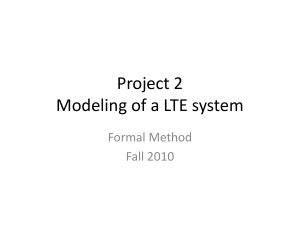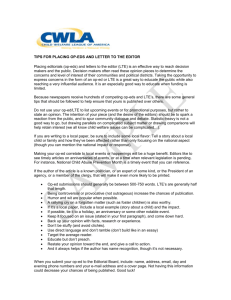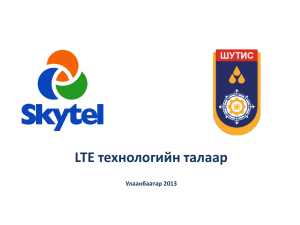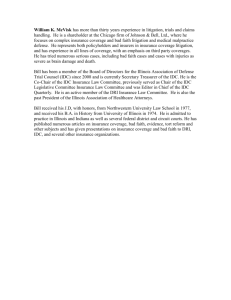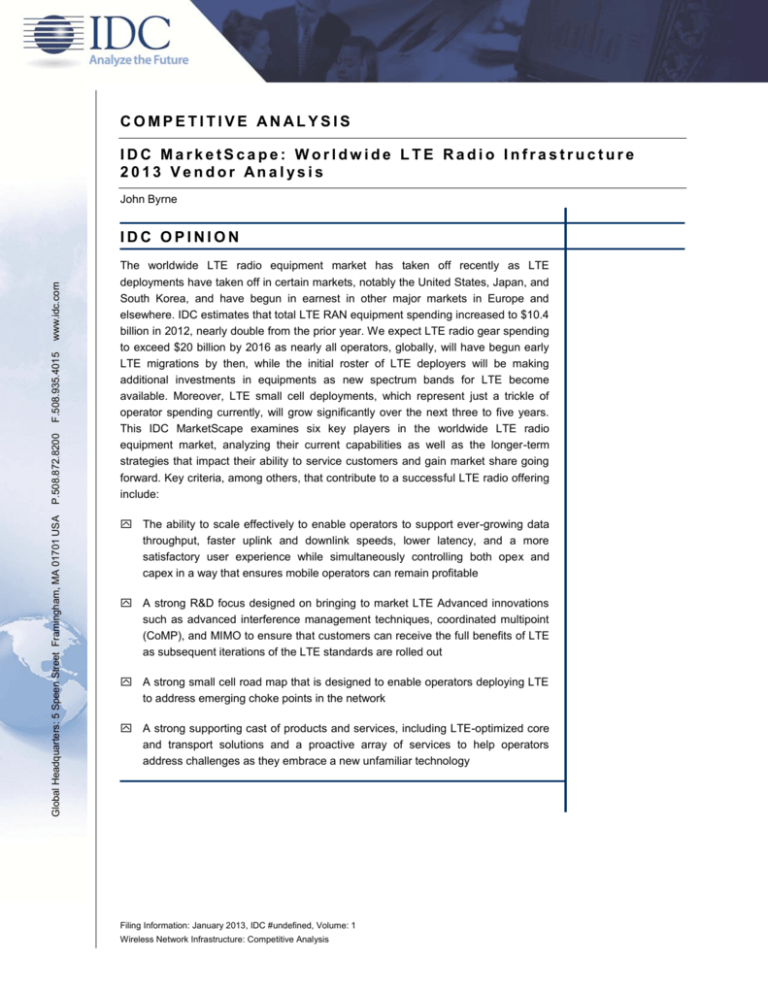
COMPETITIVE ANALYSIS
IDC MarketScape: Worldwide LTE Radio Infrastructure
2013 Vendor Analysis
John Byrne
Global Headquarters: 5 Speen Street Framingham, MA 01701 USA
P.508.872.8200
F.508.935.4015
www.idc.com
IDC OPINION
The worldwide LTE radio equipment market has taken off recently as LTE
deployments have taken off in certain markets, notably the United States, Japan, and
South Korea, and have begun in earnest in other major markets in Europe and
elsewhere. IDC estimates that total LTE RAN equipment spending increased to $10.4
billion in 2012, nearly double from the prior year. We expect LTE radio gear spending
to exceed $20 billion by 2016 as nearly all operators, globally, will have begun early
LTE migrations by then, while the initial roster of LTE deployers will be making
additional investments in equipments as new spectrum bands for LTE become
available. Moreover, LTE small cell deployments, which represent just a trickle of
operator spending currently, will grow significantly over the next three to five years.
This IDC MarketScape examines six key players in the worldwide LTE radio
equipment market, analyzing their current capabilities as well as the longer-term
strategies that impact their ability to service customers and gain market share going
forward. Key criteria, among others, that contribute to a successful LTE radio offering
include:
The ability to scale effectively to enable operators to support ever-growing data
throughput, faster uplink and downlink speeds, lower latency, and a more
satisfactory user experience while simultaneously controlling both opex and
capex in a way that ensures mobile operators can remain profitable
A strong R&D focus designed on bringing to market LTE Advanced innovations
such as advanced interference management techniques, coordinated multipoint
(CoMP), and MIMO to ensure that customers can receive the full benefits of LTE
as subsequent iterations of the LTE standards are rolled out
A strong small cell road map that is designed to enable operators deploying LTE
to address emerging choke points in the network
A strong supporting cast of products and services, including LTE-optimized core
and transport solutions and a proactive array of services to help operators
address challenges as they embrace a new unfamiliar technology
Filing Information: January 2013, IDC #undefined, Volume: 1
Wireless Network Infrastructure: Competitive Analysis
IN THIS STUDY
The worldwide LTE equipment market has seen major growth in the past few years,
with activity initially in the U.S. and Scandinavian markets spreading steadily to other
markets. As of January 2013, there were a total of 145 LTE networks in operation in
66 countries, according to the Global mobile Suppliers Association (GSA). Based on
operator reports, the GSA expects 209 networks commercially launched in 75
countries by the end of 2013. With nearly all operators utilizing 3GPP (Global System
for Mobile Communications [GSM]/UMTS) or 3GPP2 (CDMA) and WiMAX
technologies poised to migrate to LTE at some point in the next 10 years, success in
LTE is crucial to the future of network equipment vendors providing radio equipment.
This IDC MarketScape examines six key players in the LTE equipment market,
analyzing their current capabilities as well as the longer-term strategies that impact
their ability to service customers and gain market share going forward. Key criteria,
among others, that contribute to a successful LTE offering include:
The ability to provide a scalable solution that is well-equipped to handle
exponential increases in mobile data and mobile video traffic
A comprehensive and well-organized future roadmap that integrates small cells
and integrates them with existing macrocell networks
A strong portfolio of related core products and network management tools to
provide strong end-to-end support of LTE networks
Strategies that cater to both immediate opportunities in developed markets as
well as emerging medium- and long-term opportunities in developing market
Methodology
This IDC study extends the vendor assessment model called the IDC MarketScape to
the worldwide LTE equipment market. The methodology behind this model uses both
quantitative and qualitative assessments of vendors' characteristics to explain
success in the marketplace and help anticipate their growth prospects. This study
covers six vendors that provide LTE solutions, which is the key radio access
technology around which future network architectures will be built. While some
discussion of what technology will evolve "beyond LTE," it is clear to IDC that
operators are looking to subsequent releases of the IMT Advanced/LTE Advanced
standard to provide efficiency and throughput gains to support network demand for at
least the next ten years.
This evaluation is based on a comprehensive framework that assesses vendors
across a wide variety of technical and operational criteria, weighted by factors IDC
expects will be the most influential for short- and long-term LTE market success.
©2013 IDC
#undefined
1
The IDC MarketScape is designed to provide an overview of the competitive fitness of
the global solution providers in the LTE market. A single chart displays each given
company's market share and indicates whether it is over- or underperforming and
how well it is suited to compete in the market today and in the future (three to five
years from now). The accompanying text explains each contender's major strengths
and opportunities/challenges.
IDC MarketScape criteria selection, weightings, and vendor scores represent wellresearched IDC judgment about the market and specific vendors. IDC analysts tailor
the range of standard characteristics by which vendors are measured through
structured discussions, surveys, and interviews with market leaders, participants, and
operators. Market weightings are based on vendor and operator interviews, and the
input of a review board of IDC experts in each market. IDC analysts base individual
vendor scores, and ultimately vendor positions on the IDC MarketScape, on detailed
surveys and interviews with the vendors, publicly available information, and operator
experiences in an effort to provide an accurate and consistent assessment of each
vendor's characteristics, behavior, and capability.
IDC employs the following method to arrive at each company's ranking:
Sources. This study is based on a model that is populated with data provided to
IDC from a vendor questionnaire, companies' quarterly and annual reports,
earnings calls, industry analyst events, interviews with company representatives,
IDC research, and news coverage.
Market shares, growth rates, and revenue numbers. This IDC MarketScape
primarily covers the worldwide LTE equipment market. For companies that do not
publicly disclose this revenue, IDC estimates revenue and growth rates based on
public information, discussions with the vendor, and knowledge of the industry.
Competitive fitness. Each major competitor's preparedness for current and
future market conditions is expressed as a set of two scores. One score
expresses a given vendor's current "capabilities," while the other expresses the
appropriateness of its "strategies" for the future. (IDC bases its assessment of
future market conditions on what most likely will be the market's major trends and
disruptors.) Each of the two scores is broken down into three criteria (product
offer, go-to-market capabilities, business capabilities), each of which in turn is
broken down into several sub-criteria. Both criteria and sub-criteria are weighted
by importance for a particular market. For each company, we score its qualities
with regard to each of the sub-criteria, assigning a numeric value. The IDC
MarketScape model uses these values to calculate each company's score for
each of the criteria and rolls these values up to arrive at the described set of two
scores.
Definitions and Taxonomy
This IDC MarketScape addresses LTE radio access network equipment. Radio
access is one way of designing a "local loop" that connects an individual subscriber to
the telecommunications network and to the local exchange using wireless radio
technology. The radio access network is the segment of the telecom network that
2
#undefined
©2013 IDC
handles subscriber access to the network using radio technology. Typically, it
consists of antennas, towers, and radio basestation systems. In second-generation
GSM networks, a basestation system typically consists of basestations (or, more
©2013 IDC #239518 3 appropriately, base transceiver stations [BTSs] and basestation
controllers [BSCs]). In the case of the architecture for 3G UMTS/wideband code
division multiple access (WCDMA) networks, the basestation is termed Node B and
the radio network controller (RNC) subsumes many of the functionalities of the
traditional BSCs of second-generation GSM networks.
This LTE IDC MarketScape examines the LTE radio access architecture. In LTE
architectures, the eNode B performs tasks similar to those performed by the Node Bs
and the radio network controller (RNC). The aim of this simplification is to reduce
latency between network elements. In addition, eNode Bs are connected to each
other via the X2 interface and are connected to the packet-switched (PS) core
network via the S1 interface. The inter-connectivity between eNode Bs paves the way
for more efficient and responsive wireless networks but also introduces the
requirement to support many more connections between eNode Bs.
SITUATION OVERVIEW
The worldwide market for LTE radio equipment has increased exponentially in the
past several years since the first LTE markets were launched in 2009. Early launches
in Scandinavia and the United States were followed by a wave of launches in key
Asia/Pacific (APAC) markets including Japan and South Korea. Meanwhile, 2012 saw
initial launches from a number of European multinational operators. While most
markets will wade rather than jump into LTE, operating LTE alongside 3G
UMTS/HSPA and CDMA EV-DO networks for an extended length of time, it is clear
that nearly all operators will eventually shift the bulk of their network spending to LTE.
Subsequent advancements in the LTE Advanced standard will push even the most
capex-constrained operators to eventually migrate to LTE in order to generate
network efficiencies required to support increasing volumes of data traffic. Thus there
is a clear growth opportunity to be had for LTE equipment vendors for the foreseeable
future. The challenge for the players in the worldwide LTE radio equipment market is
to balance the requirement to continually invest in R&D to ensure strong technical
performance, with the need to minimize production costs in order to price to win in
future LTE operator deals.
IDC MarketScape Vendor Inclusion Criteria
IDC used the following inclusion criteria to decide which companies were to be listed
and assessed within this worldwide LTE IDC MarketScape.
Product capabilities. To take part, the vendor must have a complete portfolio of
LTE eNodeB radio equipment.
Geographical scope. The vendor's LTE solutions must be deployed on a
worldwide scope across most or all major geographical regions — Asia/Pacific
(APAC), China, Japan, Central and Latin America, EMEA, and North America.
©2013 IDC
#undefined
3
Installed base/market share. The vendor must have current market share of at
least 5% of total LTE revenue based on 1Q-3Q12 results.
The vendors should also be able to describe their current and long-term go-to-market
strategies, as well as their overall capability to conduct business globally, continue to
invest sufficiently in LTE-related R&D, provide supporting products and services
related to LTE deployment, and grow LTE-related revenue.
As a result of these criteria, and after IDC jury review, the list of vendors assessed as
part of this IDC MarketScape is as follows, in alphabetical order:
Alcatel-Lucent
Ericsson
Huawei
Nokia Siemens Networks
Samsung
ZTE Corporation
FUTURE OUTLOOK
IDC MarketScape: Worldwide LTE Equipment
Market Vendor Assessment
The IDC vendor assessment for the worldwide LTE equipment market represents
IDC's opinion on which vendors are well positioned today through current capabilities
and which are best positioned to gain market share over the next few years.
Positioning in the upper right of the grid indicates that vendors are well positioned to
gain market share. For the purposes of discussion, IDC divided potential key strategy
measures for success into two primary categories: capabilities and strategies.
Positioning on the y-axis reflects the vendor's current capabilities and menu of
services and how well aligned it is to customer needs. The capabilities category
focuses on the capabilities of the company and the LTE solutions offered today, here
and now. Under this category, IDC analysts look at how well a vendor is
building/delivering capabilities that enable it to execute its chosen strategy in the
market.
Positioning on the x-axis or strategies axis indicates how well the vendor's future
strategy aligns with what customers will require in three to five years. The strategies
category focuses on high-level strategic decisions and underlying assumptions about
offerings, customer segments, and business and go-to-market plans for the future, in
this case defined as the next three to five years. Under this category, analysts look at
whether or not a supplier's strategies in various areas are aligned with customer
requirements (and spending) over a defined future time period.
4
#undefined
©2013 IDC
Figure 1 shows each vendor's position in the vendor assessment chart.
FIGURE 1
IDC MarketScape: Worldwide LTE Radio Infrastructure Vendor
Assessment
Source: IDC, 2013
IDC believes the following factors and trends will especially shape the worldwide LTE
equipment market over the next few years:
Initial commitments by European multinational operators have been limited.
However, despite the unfavorable capex environment, these operators have been
investing in network modernization deals that will enable them to migrate to LTE
relatively seamlessly as demand dictates and as LTE spectrum comes available.
This bodes strongly for incumbent vendors who have largely maintained longstanding
relationships with European operators during network modernizations to see a long
tail of LTE deployment for the next 3 three to five plus years.
©2013 IDC
#undefined
5
The move to small cells represents a significant opportunity within the LTE
equipment market. Several operators have been at the forefront of early thought
leadership around small cells, the market is nascent, enabling other vendors to
catch up in the area of small cell deployments. While we expect macrocell
spending to account for the vast majority of LTE RAN spending in the next 3
years, success or failure of LTE small cell initiatives we examined will go far to
determining long-term success for several vendors within the LTE RAN market.
TDD LTE represents a key area of potential disruption within the LTE RAN
market. The TDD LTE market includes several potentially huge markets,
including China, India, Russia and the U.S. Ultimately we believe the TDD
opportunity will extend to areas where FDD LTE has or will be deployed initially.
As a result, vendors with a strong TDD LTE market proposition could find
themselves positioned strongly even in markets where they have not yet
established significant traction in FDD LTE.
Nokia Siemens Networks
NSN is ranked as a Leader in this LTE IDC MarketScape. It has established strong
momentum after a slow start and is earning a reputation for strong technical
performance of its LTE products as well as a strong vision for the future portfolio of
LTE products, particularly small cells.
From a product perspective, NSN's flagship offerings are the Flexi Multiradio and
Flexi Multiradio 10 basestations, which combine 2G GSM/EDGE, 3G WCDMA/HSPA,
and LTE in a single solution. The two products, and particularly the 10, feature high
capacity (up to 10Gbps), combined with a compact design and low energy
consumption. NSN's Smart Scheduler is a differentiator in the marketplace and
enables strong interference management and QoS assurance. The company's ability
to deploy six-sector sites also enables it to differentiate on both capacity and
coverage.
In small cells, NSN has emerged with a strong and comprehensive portfolio to
complement its macroportfolio. The company offers several solutions including Flexi
Lite (microcell), Flexi Zone (picocell), femtocells, in-building solutions, and Smart
WLAN (WiFi). In particular, Flexi Zone offers a unique approach to small cell
deployments that in IDC's opinion represents a strong approach to addressing
demand in the areas most likely to see the greatest challenges from a network
capacity perspective. NSN has also begun to approach small cell deployment with an
eye toward becoming not just a provider of equipment but the services that will be
necessary to provide LTE small cell connectivity, such as zoning, permitting, network
testing, and systems integration.
NSN is also making a significant investment in self-organizing networks (SON)
software, which will be a crucial element in managing challenges such as interference
management and optimizing neighbor relations in a small cell environment. The
company's SON investment is part of its overall Liquid Radio approach, which
6
#undefined
©2013 IDC
leverages smart antennas and other innovations to effective load balancing, both
across multiple nodes and within multiple access technologies.
NSN combines its LTE radio solutions with a strong focus on both core and backhaul
solutions. The company's SON solution is optimized to address both RAN and core,
and the company's Liquid Core vision includes a strong focus on virtualization as a
means to help operators make more efficient use of core investments. While the
concept of core virtualization is only now beginning to capture the interest of mobile
operators, NSN has gotten off to a strong start in helping operators move toward a
more virtualized environment, similar to the environment that is now pervasive in the
enterprise networking segment.
After a slow start in LTE, NSN has come on strong in the past two years, gaining
disproportionate market share and landing coveted positions in key LTE markets,
including Korea (all three operators utilize NSN gear for LTE), Japan (three
operators), and the United States (T-Mobile USA and U.S. Cellular). In markets such
as Europe, which have been slower to deploy LTE, NSN has successfully defended
its market position during recent network modernization initiatives. As a practical
reality, operators that have deployed NSN's Flexi multiradio basestations during
recent modernizations are likely to look to their incumbent vendor as they begin to roll
out LTE. We think this bodes well for NSN's future growth prospects in this key
geography. Elsewhere, NSN has established some traction in Latin American LTE
deployments, including the world's first commercial TD-LTE deployment for Sky
Brasil, and is in the process of rejiggering its Americas operations to win additional
opportunities in the region.
Strengths
NSN scored particularly high for its LTE Advanced product road map, the scalability
of its solutions, and a well-balanced marketing approach that is addressing the needs
of operators currently deploying LTE and the next wave of deployers likely to emerge
in Europe and Latin America. NSN is also establishing a strong reputation for LTE
product performance and support that is beginning to be recognized among
operators, providing a crucial point of differentiation in a highly competitive market.
Opportunities/Challenges
One area of potential vulnerability for NSN is its reliance on partners to provide
portions of its LTE-related portfolio beyond its radio equipment. For example, the
company sold its microwave backhaul assets to Dragonwave in 2011. While this
provided Dragonwave with a stronger combined portfolio and is consistent with NSN's
focus on providing "best of breed," the company's more limited portfolio vis-à-vis
several of its competitors is a concern for some operators.
NSN's overall financial position also remains a concern. The company embarked on a
major restructuring in late 2011, however, and has made major strides recently in its
efforts to post consistent profitability. Improving results in 2012 and a strong outlook
for 2013 have provided reassurance to many operators concerned with NSN's longterm prospects.
©2013 IDC
#undefined
7
Copyright Notice
This IDC research document was published as part of an IDC continuous intelligence
service, providing written research, analyst interactions, telebriefings, and
conferences. Visit www.idc.com to learn more about IDC subscription and consulting
services. To view a list of IDC offices worldwide, visit www.idc.com/offices. Please
contact the IDC Hotline at 800.343.4952, ext. 7988 (or +1.508.988.7988) or
sales@idc.com for information on applying the price of this document toward the
purchase of an IDC service or for information on additional copies or Web rights.
Copyright 2013 IDC. Reproduction is forbidden unless authorized. All rights reserved.
8
#undefined
©2013 IDC


